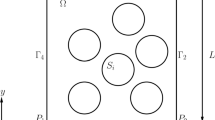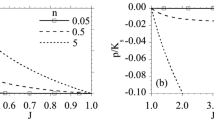Abstract
The numerical modelling of forming processes involving the flow of foams requires taking into account the different problem scales. Thus, in industrial applications a macroscopic approach is suitable, whereas the macroscopic flow parameters depend on the cellular structure: cell size, shape, orientation, etc. Moreover, the shape and orientation of the cells are induced by the flow. A fully microscopic description remains useful to understand the foam behaviour and the topological changes induced by the cell elongation or distortion, however, from an industrial point of view, microscopic simulations remain challenging to address practical applications involving flows in complex 3D geometries. In this paper, we propose a viscoelastic flow model where the foam microstructure is represented from suitable microstructure descriptors whose evolution is governed by the macroscopic flow kinematics.














Similar content being viewed by others
References
Benito S, Bruneau C-H, Colin T, Gay C, Molino F (2008) An elasto-visco-plastic model for immortal foams or emulsions. Eur Phys J E 25:225–251
Bikard J, Bruchon J, Coupez T, Vergnes B (2005) Numerical prediction of the foam structure of polymeric materials by direct 3D simulation of their expansion by chemical reaction based on a multidomain method. J Mater Sci 40/22:5875–5881
Binetruy C, Chinesta F, Keunings R (2015) F Flows in Polymers, Reinforced Polymers and Composites. A multiscale approach. Springer, Springerbriefs
Cheddadi I, Saramito P, Raufaste C, Marmottant P, Graner F (2008) Numerical modelling of foam Couette flows. Eur Phys J E 27(/2):123–133
Chinesta F (2013) From single-scale to two-scales kinetic theory descriptions of rods suspensions. Arch Comput Meth Eng 20/1:1–29
Cohen-Addad S, Hohler R, Pitois O (2013) Flow in foams and flowing foams. Annu Rev Fluid Mech 45:241–267
Feyel F (2003) A multilevel finite element method (FE2) To describe the response of highly non-linear structures using generalized continua. Comput Methods Appl Mech Eng 192/28:3233–3244
Halin P, Lielens G, Keunings R, Legat V (1998) The Lagrangian particle method for macroscopic and micro-macro viscoelastic flow computations. J Non-Newtonian Fluid Mech 79:387–403
Jeffery GB (1922) The motion of ellipsoidal particles immersed in a viscous fluid. Proc R Soc London A102:161–179
Karimi M, Droghetti H, Marchisio DL (2017) PUFOam: a novel open-source CFD solver for the simulation of polyurethane foams. Comput Phys Commun 217:138–148
Keunings R (2004) Micro-macro methods for the multiscale simulation viscoelastic flow using molecular models of kinetic theory. In: Binding DM, Walters K (eds) Rheology reviews. British Society of Rheology, Aberystwyth, pp 67–98
Lamari H, Ammar A, Cartraud P, Legrain G, Jacquemin F, Chinesta F (2010) Routes for efficient computational homogenization of nonlinear materials using the Proper Generalized Decomposition. Arch Comput Meth Eng 17/4:373–391
Tlili S, Gay C, Graner F, Marcq P, Molino F, Saramito P (2015) Mechanical formalisms for tissue dynamics. Eur Phys J E 38:33–63
Acknowledgements
This project has received funding from the European Unions Horizon 2020 research and innovation programme under the Marie Sklodowska-Curie grant agreement No. 675919.
Author information
Authors and Affiliations
Corresponding author
Ethics declarations
Conflict of interests
The authors declare that they have no conflict of interest.
Additional information
Publisher’s Note
Springer Nature remains neutral with regard to jurisdictional claims in published maps and institutional affiliations.
Rights and permissions
About this article
Cite this article
Ibáñez, R., Scheuer, A., Abisset-Chavanne, E. et al. A simple microstructural viscoelastic model for flowing foams. Int J Mater Form 12, 295–306 (2019). https://doi.org/10.1007/s12289-018-1417-4
Received:
Accepted:
Published:
Issue Date:
DOI: https://doi.org/10.1007/s12289-018-1417-4




